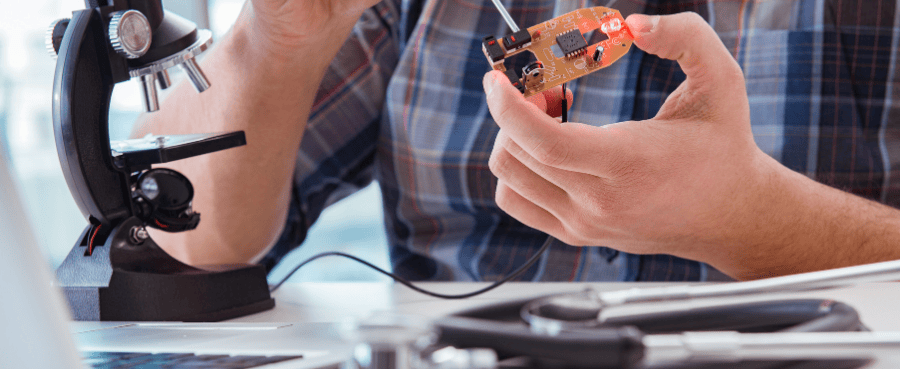Feeling lost in a sea of solder microscopes, unsure which is right for your bench? This guide cuts through the confusion.
We break down the essentials: digital vs. optical types, the critical importance of working distance, magnification, and what you can expect for your budget. By the end, you'll know exactly what to look for and can confidently choose the perfect scope for your projects. Let’s find the right tool for the job.
Quick Comparison: Digital vs. Stereo vs. Trinocular
|
Microscope Type |
Best For |
Pros |
Cons |
|
Ergonomics & recording |
Easy on the neck/eyes, great for sharing/recording, budget-friendly. |
Potential for video lag, image quality varies. |
|
|
Stereo (Binocular) |
Pure optical performance |
Zero lag (real-time view), excellent depth perception (3D view). |
It can cause eye/neck strain, and it is more difficult to record. |
|
Trinocular/Simul-focal |
The professional 'best of both' |
Use eyepieces and a camera simultaneously for zero lag and high-quality recording. |
Most expensive option. |
The Core Four: Must-Have Features for Any Solder Microscope
Getting the right soldering microscope comes down to understanding four key areas.
Working Distance: The Most Important Factor for Soldering
Working distance is the space between the bottom of the microscope lens and the top of your circuit board when it's in focus. For soldering, you need sufficient room to use a soldering iron and a hot air rework station safely and comfortably.
- Actionable Tip: Look for a minimum working distance of 100mm (about 4 inches). More is even better if a scope is perfect but lacks distance. Plan on buying a 0.5x Barlow lens, an accessory that can double your working distance.
Magnification & Field of View: Finding the Sweet Spot
It's easy to think "more magnification is better," but that's not true for soldering. Field of View (FOV) is the width of the area you can see. As magnification increases, your FOV shrinks. For soldering, you need enough magnification to see the detail, but also a wide enough FOV to see the surrounding components.
- Actionable Tip: Don't chase high numbers. A standard 7x-45x zoom range is the industry standard for a reason. It's the perfect sweet spot for nearly all electronics work.
Illumination: If You Can’t See It, You Can’t Solder It
Your beautifully magnified view is worthless if it's poorly lit. Most solder microscopes come with an integrated light source, but the quality can vary.
- Actionable Tip: Look for a built-in, adjustable LED ring light. This provides bright, direct, and shadow-free illumination right where you need it, which is essential for inspecting shiny solder joints.
The Stand: Stability and Flexibility on Your Bench
The stand holds the microscope and determines its flexibility. This is a critical part of your setup that directly impacts usability.
- Pillar Stands: Simple, vertical posts. They are cheap and save space, but limit you to working on small boards directly under the post.
- Boom/Articulated Arm Stands: These have a long arm that allows you to swing the microscope out over your workbench. They are essential for working on larger circuit boards or anything that doesn't fit in a small area.
- Practical Tip: For PCBs larger than a credit card, a boom stand is non-negotiable for flexibility. It's a worthwhile investment that you won't outgrow.

Digital vs. Optical: Choosing How You Want to See Your Work
Your first big decision is how you want to view your board. This choice affects your workflow, comfort, and the overall cost more than anything else.
The Digital Microscope: Comfort, Cost, and Recording
These microscopes use a camera to display the image on a separate monitor (via HDMI) or a computer (via USB). They are fantastic for long sessions because you can sit back comfortably, eliminating neck and eye strain.
- Checklist: Choose a digital microscope if your top priorities are comfort during long sessions, the ability to record your work, and staying on a tighter budget.
The Stereo Microscope: Zero Lag and True Depth Perception
These are traditional microscopes featuring two eyepieces that provide an accurate 3D, real-time view. Many technicians prefer the excellent depth perception and instantaneous, lag-free image.
- Checklist: Choose a stereo microscope if you are a professional who cannot tolerate any video lag and requires the best depth perception for precise component placement.
The Trinocular (Simul-Focal) Hybrid: The Best of Both Worlds
This is a stereo microscope with a third port for a camera. A "simul-focal" model is the best type, as it allows you to use both the eyepieces and the camera simultaneously without losing focus.
- Checklist: Choose a trinocular microscope if you are a serious hobbyist or professional who needs both optical precision and high-quality recording without compromise.
Related Reading: Digital vs. Optical Microscopes: An In-Depth Comparison
Popular Models to Consider in 2025
To help you get started, here are a few popular and well-regarded examples in each category. These are significant benchmarks for your own research.
The Beginner/Hobbyist (Cost: $150 - $300)
For this range, all-in-one digital microscopes are king. They give you everything you need to get started without a complex setup.
- Example Model: Andonstar AD407 Pro. This is a community favorite for a reason. It features a large, built-in screen, excellent image quality, and a tall, sturdy stand that provides ample working distance right out of the box.
The Serious Hobbyist (Cost: S$300 - $600)
This is where you enter the world of high-quality optical systems, typically simul-focal trinocular packages.
- Example Model: Eakins or AmScope 7-45x Simul-Focal Packages. Often found on sites like AliExpress or Amazon, these kits provide a proven optical head, a boom stand, an LED light, and a basic HDMI camera. They offer incredible value and are the standard choice for countless repair shops and serious hobbyists.
The Professional/Business (Cost: $600+)
In this tier, you're paying for premium optics, better cameras, and superior build quality for all-day, everyday use.
- Example Model: Higher-End AmScope or Vision Engineering. Brands like Vision Engineering offer "mantis" style ergonomic microscopes that are the gold standard for production environments, though their cost is significantly higher. For most, a premium AmScope trinocular package with a high-quality 4K camera is the pinnacle of performance and value.
Your Step-by-Step Decision Guide
Step 1: Define Your Budget and Use Case
Look at the categories above. Are you a weekend tinkere, or is this for a business? Be realistic about your needs and set a budget. There's no point in buying a professional rig if a simple digital scope will suffice.
Step 2: Avoid These Common Beginner Mistakes
- Buying cheap USB "pen" microscopes. They have almost no working distance and are useless for soldering.
- Ignoring the stand type. A cheap pillar stand will severely limit the size of the boards you can work on.
- Focusing only on magnification numbers. A usable range (7x-45x) is far better than a vast, impractical number.
- Not checking the camera's frame rate. For digital, anything less than 60 FPS will feel laggy and frustrating.
Step 3: Plan for Essential Accessories
- Barlow Lens: This is the most essential accessory. A 0.5x Barlow lens screws onto your scope to double your working distance and field of view. It's a cost-effective upgrade that significantly enhances the versatility of your microscope.
- Camera: For trinocular scopes, the camera is often a separate purchase—budget for a model that provides at least 1080p at 60 FPS.
- ESD Mat: A practical and necessary accessory for protecting sensitive electronics from static discharge while you work.
A Note on Software and Connectivity
Most cameras connect via HDMI for a direct monitor feed or USB to a computer. When using a USB, look for included software that allows for more than just viewing. Good software will let you:
- Capture high-resolution images and video.
- Perform on-screen measurements.
- Add annotations and text to your pictures.
This functionality is handy for documenting repairs, creating tutorials, or sharing your work with others.

FAQ: Quick Answers to Common Questions
1. How much magnification do I really need for SMD work?
For most SMD work, including tiny 0402 components, a magnification between 10x and 25x is perfect. A microscope with a maximum magnification of 45x provides ample power to zoom in for detailed inspection when needed.
2. What is a Barlow lens, and do I need one?
A Barlow lens is an accessory lens you screw onto the bottom of your microscope. A 0.5x lens is the most popular choice for soldering because it reduces magnification by half, while doubling the working distance and field of view. It's a highly recommended upgrade.
3. Is a 4K camera better than a 1080p camera for soldering?
Not necessarily. Frame rate is far more important than resolution. A smooth, lag-free 1080p @ 60 FPS camera is much better for real-time soldering than a choppy 4K @ 30 FPS camera.
4. What's the difference between "trinocular" and "simul-focal"?
A standard trinocular microscope forces you to switch between viewing through the eyepieces and the camera port. A simul-focal trinocular microscope is a premium version that allows you to use both the eyepieces and the camera simultaneously.
5. Can I use a cheap USB microscope from Amazon?
You can, but it's often frustrating. They typically have very low frame rates (laggy video), poor stands, and almost no working distance, making it nearly impossible to get tools underneath them. They are better suited for simple inspection than for active work, such as soldering.
In Conclusion
Choosing the right solder microscope can seem daunting, but it all boils down to a few key decisions. The "best" microscope isn't the most expensive—it's the one that perfectly fits your specific tasks, workspace, and budget. For many users, an ergonomic digital setup that emphasizes comfort and flexibility is the ideal solution.
A great example of these principles in action is the Tomlov DM602. It's a digital microscope engineered specifically for soldering, featuring a large 10.1-inch IPS screen for clear, detailed viewing. Its core value lies in the highly flexible, articulated arm stand, which provides exceptional maneuverability and a long working distance over circuit boards of any size. This combination makes it an ideal all-in-one solution for users seeking both comfort and precision.
Ultimately, whether you choose a system like the Tomlov or a different setup that suits your needs, you now know to make a wise investment. You can get back to what matters most: clean solder joints, successful repairs, and the satisfaction of a job done right. Happy soldering!




Leave a comment
All comments are moderated before being published.
This site is protected by hCaptcha and the hCaptcha Privacy Policy and Terms of Service apply.